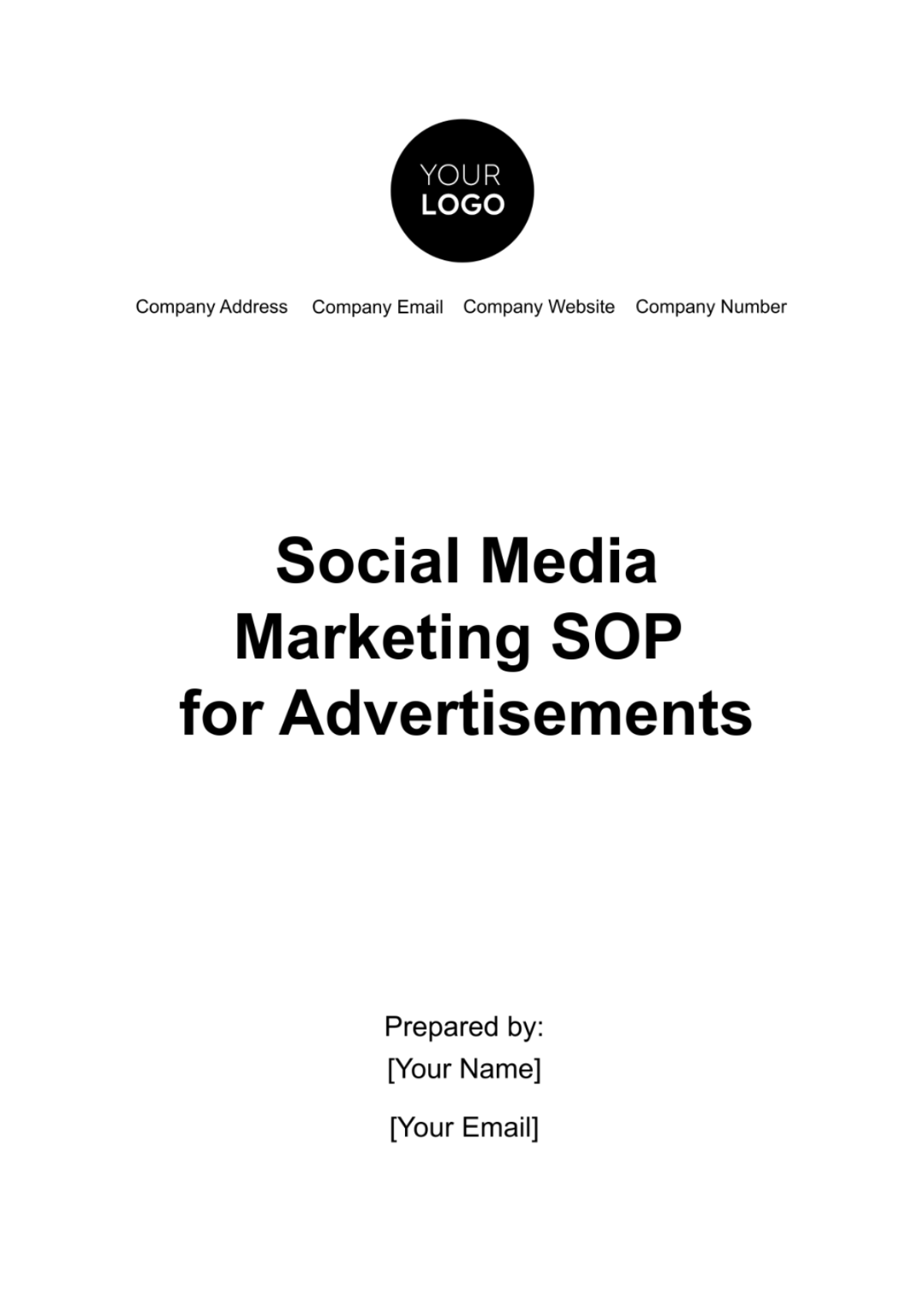Free Social Media Marketing SOP for Advertisements

for Advertisements
Introduction
Welcome to the Social Media Marketing Standard Operating Procedure (SOP) for Advertisements. In the dynamic landscape of digital marketing, the effective use of social media platforms is paramount to achieving organizational objectives. This SOP serves as a comprehensive guide for marketing professionals to navigate the intricacies of planning, executing, and optimizing social media advertising campaigns. By adhering to the procedures outlined herein, our team will not only ensure consistency in messaging and branding but also drive meaningful engagement and results across various social media channels.
Section 1: Purpose
1.1 Objective Clarification
Define the specific objectives of the social media advertisements. Clearly articulate what the marketing team aims to achieve through these campaigns, whether it be brand awareness, lead generation, or sales conversion.
1.2 Alignment with Marketing Strategy
Ensure that the goals of social media advertising align with the broader marketing strategy of the company. This subsection should highlight the importance of cohesion between various marketing channels.
1.3 Continuous Improvement
Establish a framework for evaluating the success of the social media advertising efforts. Outline procedures for learning from past campaigns, gathering feedback, and implementing improvements to enhance future performance.
Section 2: Scope
2.1 Inclusion of Platforms
Specify the social media platforms covered by this SOP. Include emerging platforms that may be relevant in the future, ensuring the document's longevity and adaptability.
2.2 Exclusion Criteria
Clearly outline any types of advertisements or content that are outside the scope of this SOP. This ensures a focused approach and prevents the misuse of resources on irrelevant activities.
2.3 Geographic Considerations
If applicable, outline any specific geographic considerations for targeting. This may involve tailoring advertisements based on regional preferences, cultural nuances, or local events.
Section 3: Roles and Responsibilities
3.1 Collaboration Procedures
Define how collaboration between different roles will occur. Highlight the need for effective communication between the Marketing Manager, Content Creator, and Ad Specialist to ensure a seamless workflow.
3.2 Training and Development
Provide guidelines for ongoing training and development for marketing personnel. This includes staying updated on the latest social media platform features and tools.
3.3 Backup and Redundancy
Establish backup roles and responsibilities in case a team member is unavailable. This ensures that ad campaigns can continue without disruption even in the absence of a key team member.
Section 4: Ad Creation
4.1 A/B Testing Protocol
Outline the process for conducting A/B testing on ad variations. This involves testing different elements such as headlines, visuals, and calls to action to identify the most effective components.
4.2 Brand Consistency
Emphasize the importance of maintaining a consistent brand image across all advertisements. Provide guidelines for ensuring that visual elements, tone, and messaging align with the established brand identity.
4.3 Ad Approval Workflow
Detail the workflow for obtaining approvals for ad content. This includes the necessary steps and individuals involved in the review and approval process.
Section 5: Targeting and Segmentation
5.1 Data Privacy Compliance
Ensure that targeting and segmentation practices comply with data privacy regulations. Specify procedures for handling and securing user data per relevant laws.
5.2 Persona Refinement
Establish a process for regularly revisiting and refining customer personas. This ensures that targeting remains accurate and relevant as customer behaviors and preferences evolve.
5.3 Competitor Analysis
Incorporate a subsection on monitoring and analyzing competitor advertising strategies. This includes staying informed about competitor campaigns and adjusting targeting strategies accordingly.
Section 6: Budgeting and Scheduling
6.1 ROI Measurement
Define the key performance indicators (KPIs) used to measure the return on investment (ROI) for each ad campaign. This includes setting benchmarks and regularly evaluating performance against these metrics.
6.2 Budget Reallocation
Establish a procedure for reallocating budgets during an active campaign. This involves identifying underperforming aspects and redistributing funds to more effective channels or segments.
6.3 Seasonal Adjustments
If applicable, outline the process for adjusting budgets and scheduling during peak seasons or special events. This ensures that the marketing strategy remains agile and responsive to market dynamics.
Section 7: Monitoring and Analytics
7.1 Real-time Monitoring
Highlight the importance of real-time monitoring of ad performance. Provide guidelines for actively tracking campaigns and promptly addressing any anomalies or issues.
7.2 Performance Reviews
Establish a regular schedule for comprehensive performance reviews. This includes analyzing historical data, identifying trends, and making strategic adjustments for upcoming campaigns.
7.3 Attribution Modeling
Detail the methodology for attributing conversions or other desired outcomes to specific ads or campaigns. This helps in understanding the contribution of each element to the overall success of the marketing efforts.
7.4 Cross-Platform Analytics Integration
Define the process for integrating analytics data from different social media platforms. This involves consolidating data from various sources to gain a holistic view of the overall marketing performance across platforms.
7.5 Predictive Analytics Implementation
Explore the potential of predictive analytics for forecasting future trends and campaign outcomes. Implement predictive models to proactively identify opportunities and challenges, enhancing the strategic planning of future campaigns.
Section 8: Compliance and Legal Considerations
8.1 Regular Compliance Audits
Outline the schedule for conducting regular audits to ensure ongoing compliance with platform policies and legal requirements. This includes reviewing content, targeting parameters, and data handling practices.
8.2 Legal Liaison
Specify the role of legal professionals or liaisons in the advertising process. This involves consulting legal experts to ensure that all content and practices adhere to relevant laws and regulations.
8.3 Crisis Communication Planning
Expand on the crisis management procedures by detailing a communication plan. This includes how to communicate with the public, stakeholders, and regulatory bodies in the event of a significant compliance or legal issue.
8.4 Vendor Compliance Management
If applicable, establish a protocol for ensuring compliance among third-party vendors involved in advertising activities. This includes vetting vendors for adherence to legal and ethical standards to mitigate potential risks.
8.5 Ethical Advertising Standards
Define ethical standards for advertising content and practices. Ensure that all advertising efforts align with the company's values and ethical guidelines, promoting transparency and trust with the audience.
Section 9: Crisis Management
9.1 Employee Training for Crisis Response
Provide guidance on training team members for crisis response. This includes communication protocols, public statements, and steps to mitigate the impact of any negative situations.
9.2 Escalation Protocol
Establish an escalation protocol for handling severe crises. Clearly define the steps to escalate issues to higher management or external crisis management experts when necessary.
9.3 Post-Crisis Analysis
Outline the process for conducting a post-crisis analysis. This involves assessing the effectiveness of the crisis response and implementing improvements to prevent similar issues in the future.
Section 10: Reporting and Documentation
10.1 Actionable Insights
Specify how marketing personnel should extract actionable insights from reports. This involves translating data into actionable strategies for future campaigns.
10.2 Documentation of Best Practices
Encourage the documentation of successful strategies and best practices. This serves as a knowledge repository for the team, facilitating continuous learning and improvement.
10.3 Cross-Channel Integration
If applicable, provide guidelines for integrating insights from social media advertising reports with data from other marketing channels. This holistic approach ensures a unified and optimized marketing strategy.
Conclusion
This SOP establishes a framework that empowers our marketing team to harness the full potential of social media advertising. As we navigate the ever-evolving digital ecosystem, the guidelines outlined here will provide a roadmap for creating impactful campaigns, fostering audience connections, and achieving measurable success. By embracing continuous improvement, staying compliant with industry standards, and adopting an agile marketing approach, we position ourselves for excellence in social media advertising. Let this document be a beacon, guiding us towards strategic and effective utilization of social media for the continued growth and success of our brand.
- 100% Customizable, free editor
- Access 1 Million+ Templates, photo’s & graphics
- Download or share as a template
- Click and replace photos, graphics, text, backgrounds
- Resize, crop, AI write & more
- Access advanced editor
Optimize your ad campaigns with Template.net's Social Media Marketing SOP for Advertisements Template. This editable and customizable tool, accessible through our Ai Editor Tool, provides a systematic approach to streamline your advertising process. Tailor it to your needs effortlessly, ensuring consistency and effectiveness in your social media marketing endeavors.
You may also like
- Instagram Ad
- Instagram Banner
- Instagram Frame
- Instagram Post
- Instagram Profile Picture
- Instagram Story
- Instagram Story Highlights
- Twitter Ad
- Twitter Header
- Twitter Post
- LinkedIn Photo
- Linkedin Post
- YouTube
- Youtube Ad
- Youtube Banner
- YouTube Channel Art
- YouTube End Screen
- Youtube Profile Photo
- YouTube Thumbnail
- Facebook Ad
- Facebook Cover
- Facebook Post
- Facebook Profile Frame
- Facebook Profile Photo
- Twitch Offline Banner
- Linkedin Banner
- Twitch Overlay
- Whatsapp Status
- Reddit Banner
- Social Media Banner
- Social Media Clipart
- Social Media Plan
- Social Media Contract
- Social Media Planner
- Social Media Report
- Social Media Agreement
- Social Media Business Card
- Social Media Proposal
- Social Media Presentation





























